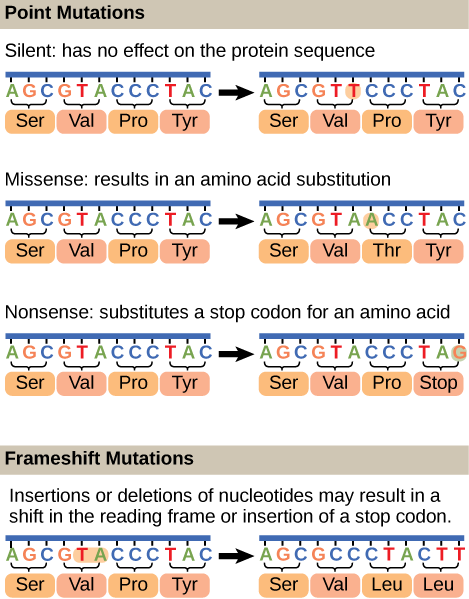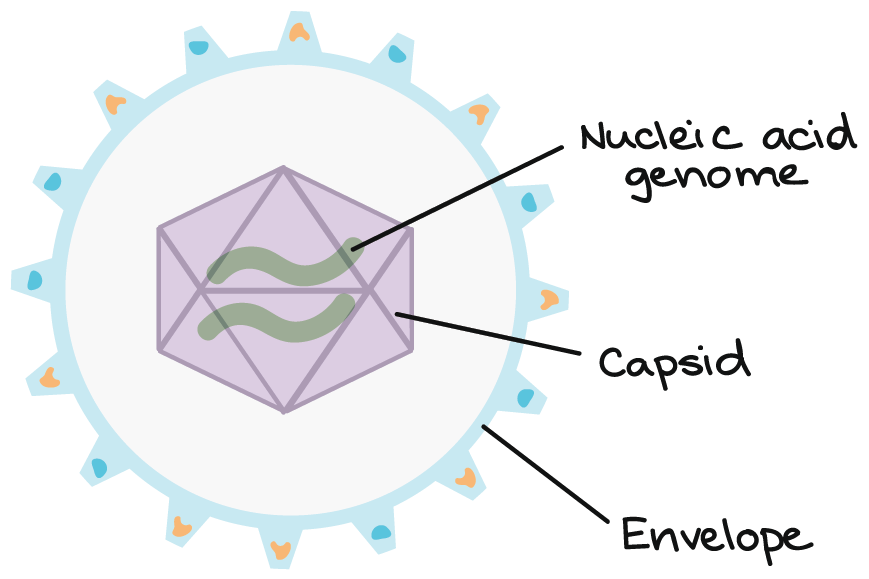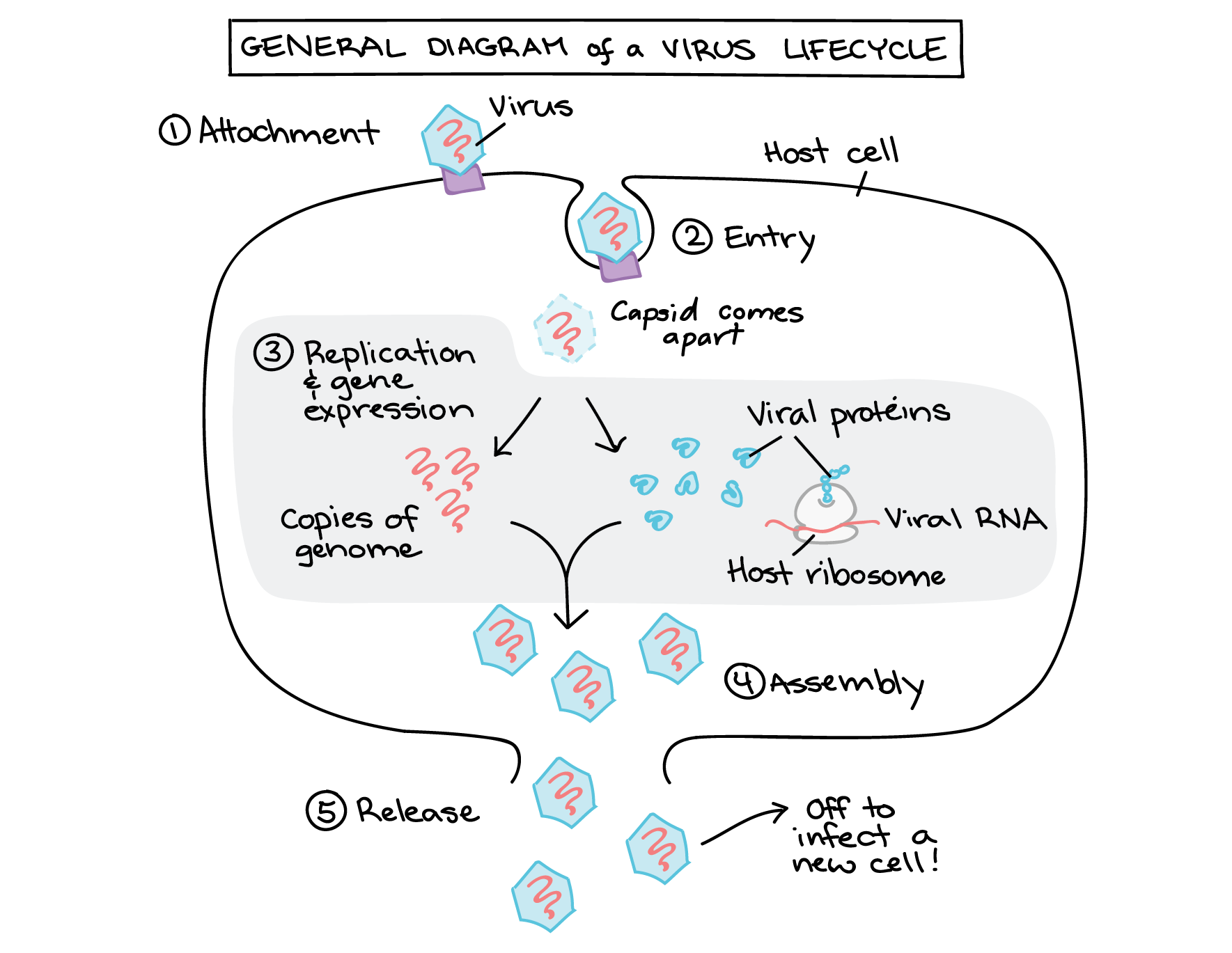Mutations
Mutations are modifications in DNA that cause it to be different from the original DNA molecule that it was replicated from. Mutations can be caused by mutagens, which are radiation or chemicals. Carcinogens are one example of mutagens that cause cancer.
There are different types of mutations:
- Point mutations are errors that only affect single nucleotides rather than whole parts of the DNA strand. There are different types of point mutations.
- Substitutions are when the new replicated DNA contains a different nucleotide from the original DNA strand in one position. An example is ATTGTC → ATTCTC.
- Deletions are when a nucleotide is deleted. An example is ATTGTC → ATTTC.
- Insertions are when a nucleotide is added to the strand. An example is ATTGTC → ATTAGTC.
- Silent mutations are mutations that don't affect the coded amino acids. The final protein will not be affected by this type of mutation. Silent mutations are usually lucky. More than one codon can code for the same amino acid. If the mutation happens to turn one codon into another codon that codes for the same amino acid, there will be no change in the protein.
- Missense mutations are unlucky silent mutations. In case the new codon codes for a different amino acid than the original, the final protein will be affected. This change can be disastrous. Sickle-cell disease is caused by a missense mutation.
- Nonsense mutations are mutations that cause a codon to turn into a stop codon. This leads to a part of the DNA not being used to create a protein. Just like missense mutations, nonsense mutations can have disastrous effects.
- Chromosomal aberrations are mutations that occur in the chromosomes. There are a couple types of chromosomal aberrations:
- Deletions are when some of segments of a chromosome are removed. A loss of DNA is usually fatal as some proteins cannot be produced.
- Duplications are chromosome segments that are repeated. Since the repetition is moving other chromosomes to different positions, this is a frameshift mutation. Duplications may be beneficial. If a segment of the chromosomes needs to produce a large quantity of proteins, it can be done if there are two sites that contain the DNA for the protein.
- Inversions are segments of the DNA that are reversed. It may not have much of an effect if the affected segment of DNA is not used very much.
- Translocations are when parts of the chromosome are deleted, reversed, and then inserted back into either the same chromosome or a different one.
- Transposons are naturally occurring mutations. DNA segments insert themselves into different places in the genome after either being copied or deleted from another part of the genome.
Deletions are insertions are also called frameshift mutations because adding or deleting a nucleotide also affects the nucleotides at each position after the modified nucleotide. In the deletion example, nucleotide 4 changed from G to T, but nucleotide 5 also changed (from T to C). Similarly, in the insertion example, nucleotide positions 4, 5, and 6 changed.

Viruses
Viruses can infect cells and use cells to reproduce. Bacteriophages are viruses that invade bacterial cells.
Viruses have different basic structures:
- A nucleic acid (either DNA or RNA) contains the virus's genetic information. The DNA or RNA might be either single stranded or double stranded.
- Capsid/protein coat contains the nucleic acid.
- An envelope is found in some viruses. They surround the capsid of the virus.

Viruses follow one of two cycles:
- The lytic cycle is when the virus injects its nucleic acids into the host cell. The host cell unknowingly uses the nucleic acids to create a new virus, which then destroys the cell. The new viruses also infect other cells and the process continues.
- The lysogenic cycle is when the nucleic information of the virus is incorporated into the host cell's DNA but is not expressed or used to create a new virus. When an external stimulus is applied, the virus may start to be produced, effectively leading it into the lytic cycle.

Retroviruses are viruses that contain an enzyme called reverse transcriptase. The virus injects RNA into the host cell. Reverse transcriptase uses RNA to create the corresponding DNA strand, which is incorporated into the host cell's genome. The virus can either enter the lytic or lysogenic cycle. RNA viruses high rates of replication errors because RNA replication does not have many mechanisms that check for errors and fix the errors. The high rate of replication can lead to a high mutation rate, which allows the virus to easily evade vaccines.
Prokaryotes
Unlike eukaryotes, prokaryotes do not contain a nucleus or specialized organelles. Their genetic material is a single circular DNA molecule. Unlike eukaryotic cells, which reproduce using mitosis and meiosis, prokaryotic cells reproduce reproduce using binary fission. During binary fission, the chromosome is replicated and one is placed into each of the two new cells.
Along with a singular circular DNA molecule, prokaryotes also contain plasmids, which are short circular DNA molecules located outside the chromosome. R plasmids allow the bacteria to be resistant against antibodies.
Prokaryote replication starts at a single origin and works outward in both directions.
Prokaryotes are able to modify their DNA and have genetic variation through a process called horizontal gene transfer. There are 3 ways in which genetic variation can be introduced in prokaryotes:
- Conjugation is DNA exchange between bacteria. One bacterium create a pili (a small tube) that connects to another bacterium. A plasmid DNA is sent through the tube to another bacterium. The sent DNA is incorporated into the recipient cell's DNA by recombination, causing genetic variation.
- Transduction is the process in which a virus introduces new DNA to a bacterium. When a virus is produced by one bacterium, some of its DNA may make up a part of the virus's DNA. The virus infects another bacterium and in the process, the two bacterium's DNA recombine.
- Transformation is the process by which bacteria absorb DNA from their environment.
